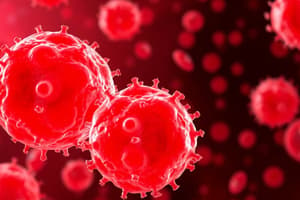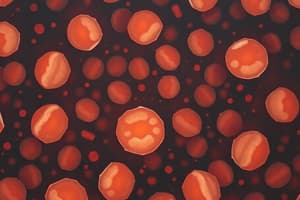Podcast
Questions and Answers
What are the primary functions of white blood cells?
What are the primary functions of white blood cells?
- Blood clotting and healing injuries
- Defense against infection and disease (correct)
- Oxygen transport and nutrient delivery
- Regulation of body temperature
Which of the following disorders is primarily associated with red blood cells?
Which of the following disorders is primarily associated with red blood cells?
- Anemia (correct)
- Hemophilia
- Lymphoma
- Leukemia
What is the process of hemostasis?
What is the process of hemostasis?
- Process to stop bleeding (correct)
- Formation of white blood cells
- Production of red blood cells
- Infection fighting mechanism
Which type of white blood cell is primarily involved in allergic reactions?
Which type of white blood cell is primarily involved in allergic reactions?
What is a common symptom of red blood cell disorders?
What is a common symptom of red blood cell disorders?
In coagulation disorders, which factor is most commonly affected?
In coagulation disorders, which factor is most commonly affected?
Which of the following is a characteristic of leukemia?
Which of the following is a characteristic of leukemia?
What role do platelets play in hemostasis?
What role do platelets play in hemostasis?
Flashcards are hidden until you start studying
Study Notes
White Blood Cell Disorders
- Disorders affecting white blood cells may involve alterations in their production, function, or characteristics.
- High white blood cell counts (leukocytosis) often indicate infection, inflammation, or malignancy.
- Low white blood cell counts (leukopenia) can increase susceptibility to infections.
- Types of white blood cell disorders include leukemia, lymphomas, and myelodysplastic syndromes.
- Leukemia is a cancer of blood-forming tissues leading to excessive production of abnormal white blood cells.
- Lymphomas are cancers that originate in the lymphatic system, affecting lymphocytes.
- Aplastic anemia is characterized by the failure of the bone marrow to produce adequate blood cells.
Red Blood Cell Disorders
- Red blood cell (RBC) disorders can result from issues in production, destruction, or loss of RBCs.
- Anemia is a condition marked by insufficient hemoglobin or red blood cells, leading to fatigue and weakness.
- Hemolytic anemia occurs when RBCs are destroyed faster than they can be produced.
- Iron deficiency anemia is the most common type and results from inadequate iron for hemoglobin production.
- Sickle cell disease is a genetic disorder leading to misshapen red blood cells that impair oxygen transport.
- Polycythemia vera is a condition characterized by an overproduction of red blood cells, increasing blood viscosity.
Hemostasis and Coagulation Disorders
- Hemostasis refers to the process that prevents and stops bleeding, involving a complex interaction between blood vessels, platelets, and proteins.
- Coagulation disorders result from deficiencies or abnormalities in clotting factors, leading to increased bleeding or thrombosis.
- Hemophilia is an inherited disorder affecting the body's ability to control blood clotting due to insufficient clotting factors.
- Vitamin K deficiency can impair synthesis of clotting factors, leading to bleeding conditions.
- Thrombophilia increases the risk of blood clots due to abnormal coagulation processes.
- Disseminated intravascular coagulation (DIC) is a serious condition characterized by the systemic activation of blood clotting leading to multi-organ complications.
Studying That Suits You
Use AI to generate personalized quizzes and flashcards to suit your learning preferences.




